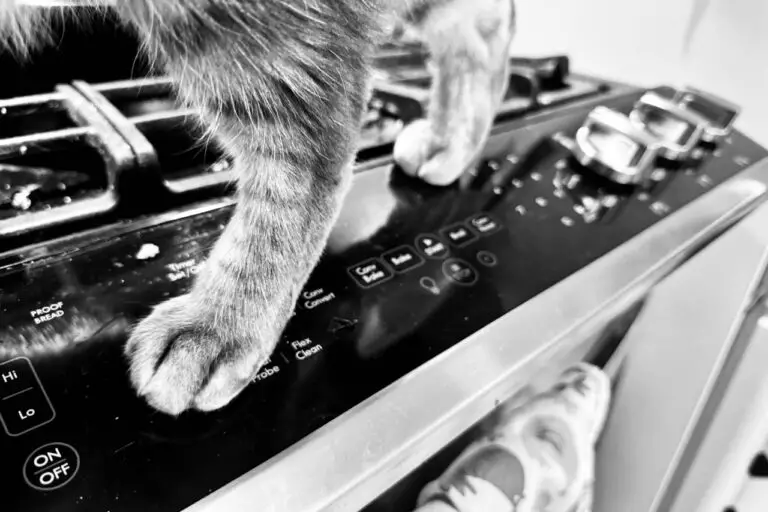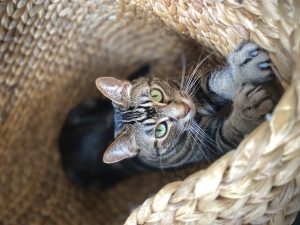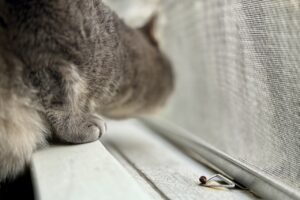How to Cat-Proof Your Kitchen
Your kitchen = cat playground. The kitchen is also filled with potential dangers to cats. I have a pretty solid example…
My cat has switched on my oven. Twice! I’ll share some details on that later, but trust me – when it comes to cat-proofing your home, you really don’t want to skip the kitchen. In fact, that’s probably where you should start.
This article will help you make sure your kitchen is cat-proof – or at least as cat-proofed as it can be.
Let’s start with a checklist of the main things you need to address.
Trash
Unsecured trash can kill a cat
Cats will get into the trash if they can access it. When that happens, the best case scenario is that you have a mess to clean up.
But far worse can happen, because what your cat finds can make them very sick. And in the case of cooked bones, toxins, or ribbons, it could even be lethal.

Get a proper trash can
The simplest solution for trash is to keep it under the kitchen counter, either inside a cabinet or in a pull-out drawer. That way, as long as the cat can’t open the cabinet or drawer, the trash is never accessible.
If under-counter storage isn’t an option (which is the case for me in my current home), then you need a free-standing trash can with a secure lid.
The kind with a foot-lever for opening is perfect for this. But not the kind that opens inward, because of course the lid needs to be able to support the full weight of your cat.
Cheaper ones that are tall with a hinged lid are fine too. But remember, even if your cat can’t open the lid, tipping the can over may still be possible.
Putting a heavy weight in the bottom of the container can prevent this. You can also anchor the container to a wall or cabinet so that it can’t be toppled, but that can make it a bit of a pain to change out old bags for new.
Be selective about what you put in your kitchen trash
When it comes to the stuff that could actually kill your cat, the safest thing to do is take it straight out to your garbage can or dumpster.
Especially with chicken bones that your cat definitely will smell and be tempted by, best not to leave it to chance. Cooked bones can splinter and cause major internal damage to a cat.
Compost
Much of what we’ve said about trash also applies to compost. Be mindful of what you put in the compost and the kinds of foods that could harm your cat.
If you keep your kitchen compost on the counter, make sure it’s in a container with a tight fitting lid. There’s always the chance though that your cat will figure out how to push it off the counter, knocking that lid off in the process.
Better yet, keep compost in a cabinet under the sink, or even outside.
Food
Mind your countertops, tabletops, and food prep areas
- Keep countertops and dining tables clear of unattended plates
- Don’t leave dirty pans and dishes out on the stove or in the sink.
- Keep cutting boards and knives away from the edge of the counter.
- Mind your feet as you move around the kitchen – a quiet cat can easily become a trip hazard while carrying something hot
- Cover foods that might be tempting to your cat
Foods that are toxic to cats
Some human foods are actually toxic to cats, or can make them sick. Educate yourself (and everyone in your home) on which ones.
Here are some examples:
- Chocolate
- Onions
- Garlic
- Grapes
- Avocado
- Raisins
- Yeast
- Almonds, walnuts, macadamia, and other nuts
- Anything with xylitol (a common sweetener) in it
- Raw eggs
- Citrus
- Liver
- Dairy
- Anything with alcohol in it
- Caffeine
I went a long time not knowing about some of the things on this list. My cats will get into almonds, bread, and avocado (when cut open) if I’m not careful.
Stove
To prevent paw burns, you can use burner covers immediately after using the stove. You can also use knob covers to cover the stove’s knobs when not in use. This makes it impossible for your cat to turn a burner or the oven on inadvertently.
There’s a lot I don’t love about my stove, and the touch button control panel is at the top of the list.
My cats have actually turned the oven on twice, just by jumping up onto the front of the stovetop. So I have to remember to unplug the entire appliance after each time I use it.
Just as with countertops, don’t leave food accessible to your cat on the stove top. Once they’re rewarded with a tasty treat for jumping up there, they will return for more in the future.
Refrigerator
Here are a few hazards to keep in mind with the fridge:
- Just as with washers and dryers, always make sure your cat hasn’t jumped inside.
- Fill in any spaces between your fridge and the wall so that it doesn’t become a hiding spot for your cat that you can’t reach
- Make the electrical cord to the fridge inaccessible
- Consider the possibility that your cat will try to jump onto the top of the fridge. If this could be dangerous or you simply don’t want this to happen, you’ll need to find a way to prevent it. I do this by having my microwave up there, but it doesn’t prevent it completely.
Storage
Proper storage can go a long way in preventing your cat from getting into things that could be harmful. Cats can rip open plastic bags if they smell something tempting inside.
Use containers with tight-fitting lids to store pantry items, especially those on the list of toxic items above.
Make sure drawers, cabinets, and pantry doors shut securely, and that everyone in your home knows to keep them closed. If things don’t shut securely, use child locks to keep your cat out.
In addition to off-limits food items, there are some other important hazardous things to make sure are securely stored.
These include:
- Cleaning supplies
- Pesticides
- Rodenticides
- Rubberbands
- Plastic bags
- any bags with handles (remove handles from paper bags before letting your cat play with them).
Last Meows
We hope this guide helps you make your kitchen more kitty-compatible. Be sure to check out our comprehensive cat-proofing guide if you want to get serious about the rest of the house.

